Everything is done the same way in Sigma Studio without any problems. Well, that doesn't matter.
Based on my little experience in setting up a multi-band speaker system, I see one problem: mixing the bands by ear is very difficult if you do not have a lot of experience in mixing speakers. So this application looks more like a toy than something useful. To mix speakers, it is better to use not your ears, but a microphone and automatic equalization in Sigma Studio.
https://wiki.analog.com/resources/t...udio/toolbox/adialgorithms/automaticspeakereq
https://ez.analog.com/dsp/sigmadsp/f/q-a/64304/adau1701-sigmastudio-rew-auto-eq
I am brand spanken new to DSP's. I was happy to get my JAB5 board talking to SS (SigmaStudio) and able to download a 2.1 sample project. When I loaded the sample 2.1 project into the DSP it didn't drive the left speaker channel of my setup... which I have since figured out is due to the J13 (the Left/Right amp) speaker outputs being swapped with J14 (the bridged sub amp) speaker outputs between the default Wondom 2.1 program and the sample 2.1 project. Now that I have figured this out I will have a SigmaStudio project to play with. I have also found the default JAB5 2.1 project so I can now get back to the default DSP config.
One part of the sample 2.1 SS project concerns me. The Bluetooth input is mixed with the analogue input and there is no way to hard switch from one input to the other. I will have to see if this is a real problem or not.
I respect that a linear response is by far the best place to start but I also know I prefer to shape the response curve. I don't know if it is better to shape the the music in the EQ in my phone or with the DSP crossover curves. My hunch is it will be a combination of both? Remember, I am just balancing some VERY well tuned off the shelf speakers that have very good passive crossovers with my DIY sub. I am not balancing the ribbon tweeter with the woofer within the external speakers. I deliberately went with some very good bookshelf speakers instead of building (and tuning) my own so I won't have to dive into the world of speaker/crossover design.
I kind of had an idea that there should be some sort of digital tuning capability for SigmaStudio. I am happy to find out this capability is built into SigmaStudio and not something that I have to use another speaker tuning app to achieve. I really appreciate the info and links!
Last edited:
I love the look! I hope my box turns out as nice!
The lamination pattern of the glulam beech is very similar to the glue up pattern in the kitchen table I am repurposing. I am a little concerned about the resonance and liveliness of hardwood vs the deadening characteristics of MDF. I know glulam is stronger than a chunk of solid wood and I would assume this also extends to less resonance of glued up wood. My gut feeling is that the liveliness won't be problem but I could apply measures to the inside surfaces of the box if it is too lively (not that I would know how to tell if it is too lively LOL!).
What is "simili covering"?
Yes @oughtsix , you are right about Glulam woods.
ere in France in some DIY supermarkets, we can find Glulam of :
- Beech wood : one of the best utility wood, nice look, stable, hard enough ot be abuse resistant and easy to work.
- Acacia wood : similar to Beech wood, a bit lighter, more whitish and nervous, not as hard as Beech wood.
- Oak wood : hard, heavy, rather dark in color, the most abuse-resistant but also more difficult to work.
- Pine wood : lighter, softer and often uneven in look and to work (questionable homogeneity).
The stronger / the harder = the higher tone in resonance. This is as true for Solid as for Glulam wood. But yes, Glulam is a bit more "inert" in terms of resonance, if I can say so...
If we take two 18mm thick panels of same external dimensions, say A4 format : one in MDF, one in Beech wood Glulam...
- The tone resonance of the MDF will be higher in frequency and intensity than the Beech wood Glulam, when knocked. I know that this may be surprising, but that's what I experienced several times...
That's one of the reason why I do not use anymore MDF for enclosures (nor anything, by the way !) : questionable resonance damping effect, a pain to work (that awful dust, unsharpening tools, try to put a screw in it without splitting, etc...), poor abuse bump and flex resistance... Plus unpresentable look as is.
For me now, when it turns to cabs : or Glulam or Plywood !
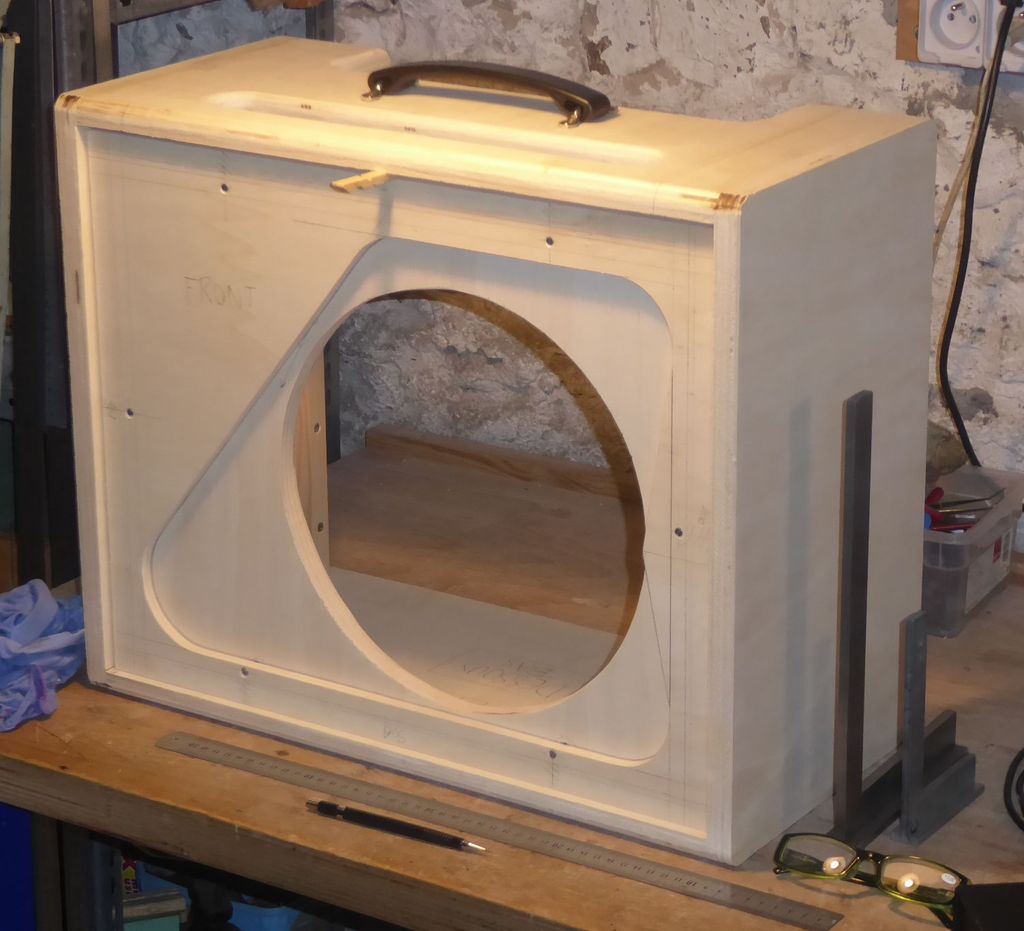
But OK, we are drifting from the original subject : Are Class D (TPA) amps really that much better than Class A/B amps?
Except for Subwoofer applications - where indeed a Class D is successful - I stick to analogue Class A / class AB amplification, stereo and passive crossovers, without any signal processing... In one word : Old School ! 🙂😉
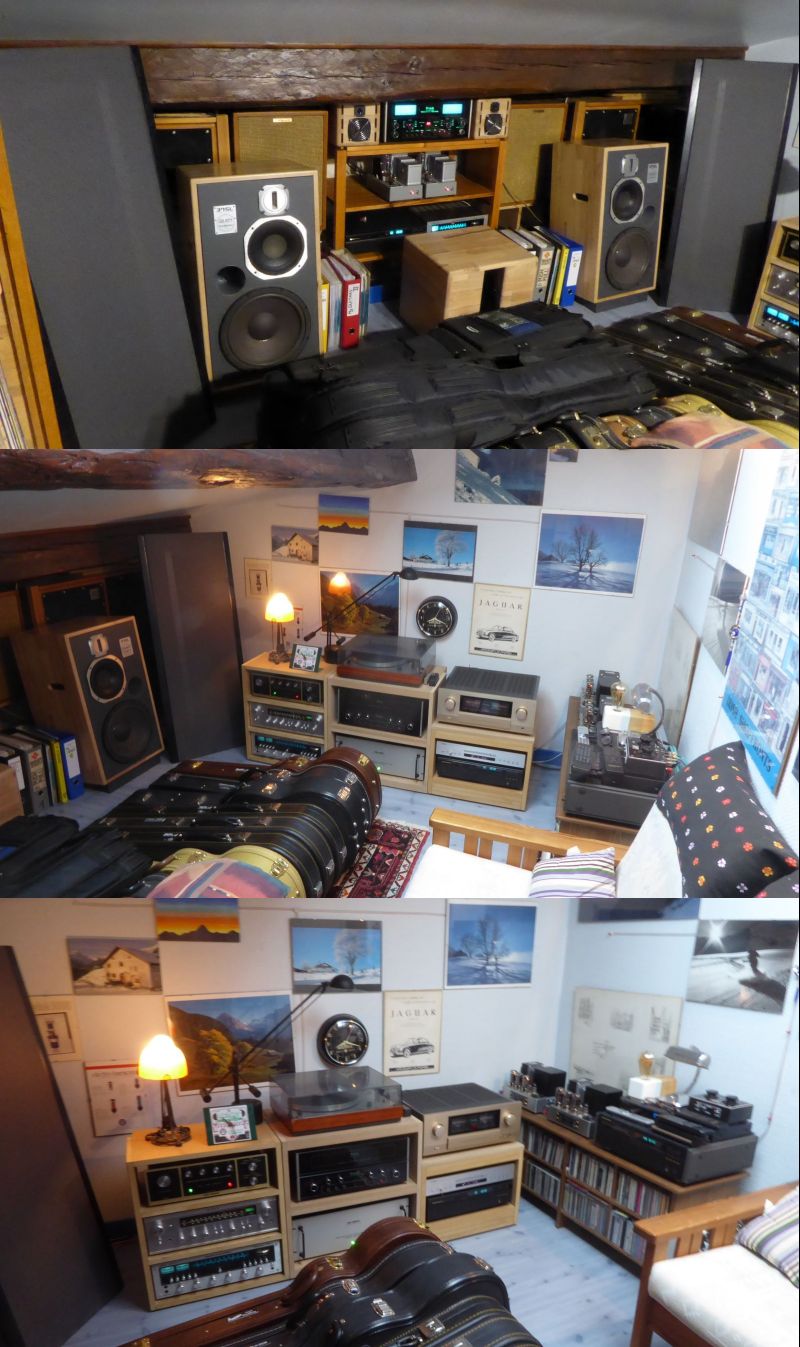
T
Oh sorry... I forgot : what is "Simili" ?
"Simili" is a plastic simili-leather cloth, an imitation of leather... "Similar to leather" in other words - I think that you indeed see what I mean now : you see the round cuts in upper left pic below. I glue it on the wood with water-solvent neoprene glue :
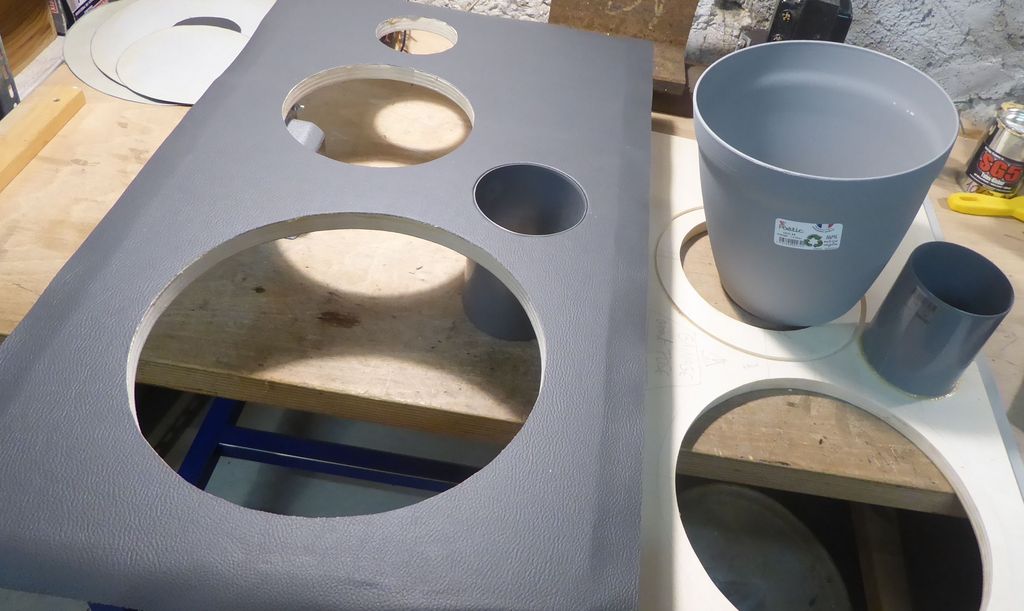
Grey-Tumbled Simili finish on Plywood, easy to work and very presentable :
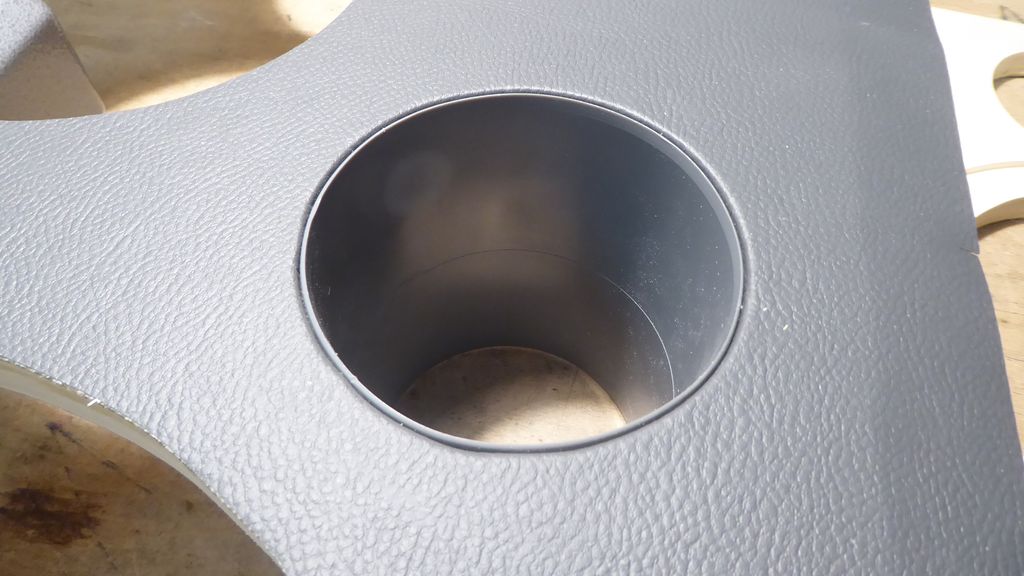
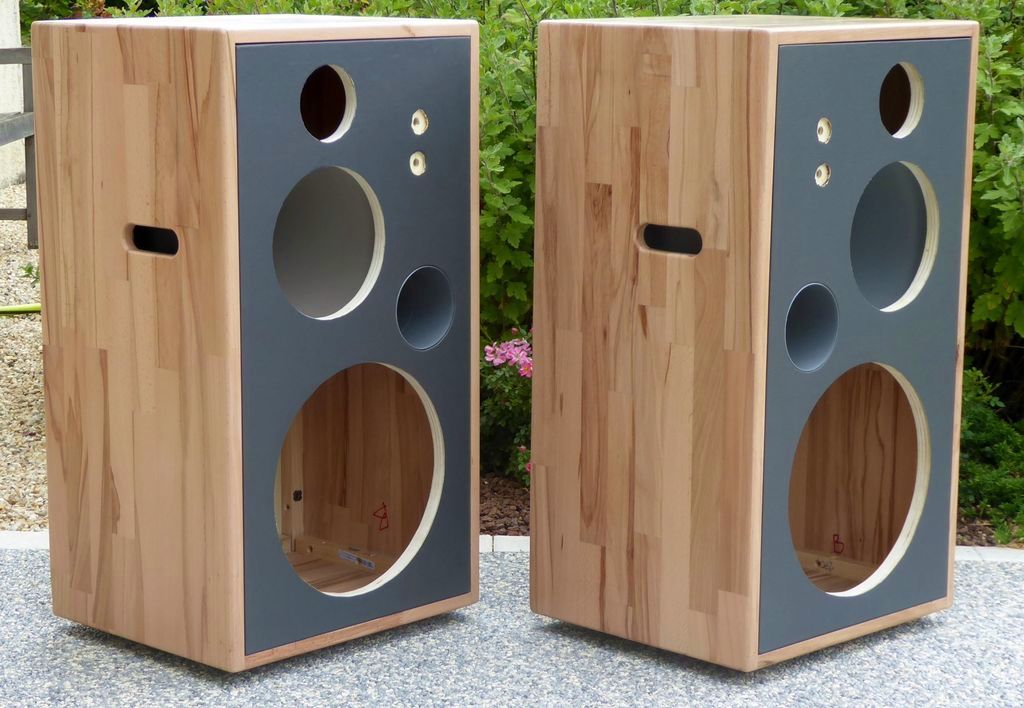
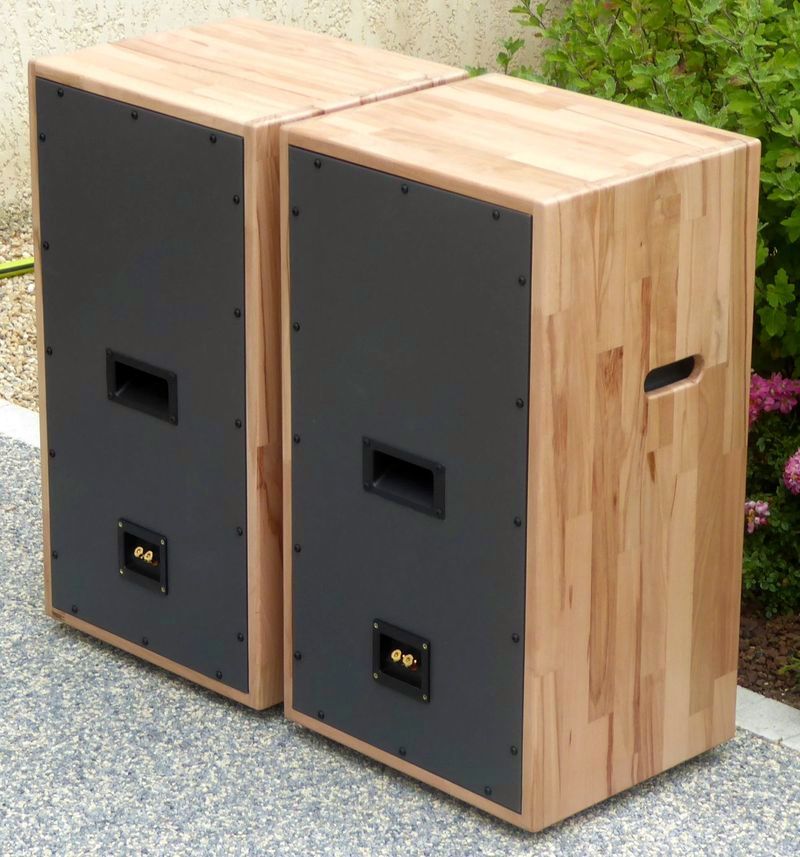
T
"Simili" is a plastic simili-leather cloth, an imitation of leather... "Similar to leather" in other words - I think that you indeed see what I mean now : you see the round cuts in upper left pic below. I glue it on the wood with water-solvent neoprene glue :

Grey-Tumbled Simili finish on Plywood, easy to work and very presentable :



T
Absolutely love the old school look of those speakers. Can’t stand the modern curvy designer stuff!
Is there a build thread anywhere?
Is there a build thread anywhere?
For "better" to have concrete meaning in electronics its a good idea to define a figure of merit based on the various performance specifications. Although disparate things like distortion and efficiency aren't really commensurate, so this is rather contrived. Better to define a set of requirements and ask "is this amp good enough for my requirements?"
A tight efficiency requirement will limit to classes D maybe also G and H.
A tight distortion or damping factor requirement will rule out class D probably...
A tight efficiency requirement will limit to classes D maybe also G and H.
A tight distortion or damping factor requirement will rule out class D probably...
Already nonlinear distortions in class D are negligible. And the damping coefficient in class D has always been at a high level.A tight distortion or damping factor requirement will rule out class D probably...
Absolutely love the old school look of those speakers. Can’t stand the modern curvy designer stuff!
Is there a build thread anywhere?
I must confess that yes, 😕 I don't like too much those "modern curvy" shapes too...
A tight efficiency requirement will limit to classes D maybe also G and H.
Yes. It's at least one of their main advantage : efficiency.
A tight distortion or damping factor requirement will rule out class D probably...
Oh, I would have thought that the damping factor in class D would have been conversely very high, compared to class A and AB... 🤔🤔🤔
According to their specs (at 8R / 1kHz, when noted) :
My Audio Research D76 (tubes, 2x75W) from 1974 offers a damping factor of 14.
My McIntosh MA6800 reaches 40, and MC7100 goes to 200.
My Marantz receivers 2250B and 2270 are also at 40-50.
My Accuphase E-560, which is a pure class A, offers 400.
My SE tube amps (pure class A 300B, KT120) measured at 2 and 4.
While :
My ATOHM S-250 subwoofer amplifier Class D module damping factor is "over 1000" at 8R / 100Hz, for an efficiency over 80%...
T
You've been using cheap chip amps and still like class D? 😲 If you need considerably more power or better distortion performance, try Hypex (NCore or later) or Purifi based amps 😉In 2021 I bought a $35 TPA3116 2.1 amp for portable music. I was actually quite impressed with it. It really made a set of SLS (Superior Listening System) ribbon bookshelf speakers sparkle. I used the trio for camping for a few years and to shut up those obnoxious shrill pill box speakers that friends would bring camping.
I decided to build a passive 6" sub with a pair of 7" radiators and the cheap TPA3116 broke down. So I bought a WONDOM AA-JA33286 JAB5 4x100 Watt Class D (i.e. Dayton Audio KABD-4100 4 x 100W) with DAU1701 DSP and dual TDA7498E amp chips for 2 x 100w + 200w subwoofer. I am very impressed! The SLS speakers aren't noticeably cleaner (still REALLY impressive though) but my DIY passive sub really came to life! So it is time to integrate the amp board, sub, radiators, 12x18650 batteries (29vdc), and 36v 10A ps into a boombox format with mounts for attaching the SLS speakers where they are easily removable for better imaging. After a week with the separate pieces in my shop (I am a woodworker) I REALLY grew fond of the setup while building the box. Now that it is time to wire everything into the box I am really missing having music in the shop.
So I pulled out my ancient Yamaha RX-V2090 receiver. MAN IT SOUUNDS LIKE CRAP!!!! My old RX-V890 was no better. My current Yamaha Aventage 2010 is no better than the old Yamahas either. I can't believe how bad the old Class A/B amps are in comparison to a Class D! I had a Threshold 400A amp, Anthem pre and Magnepan II speakers when I was using the Yamaha receivers for HT and I knew the Threshold Class A 400a amp blew the Yamaha away for clarity, detail, and imaging but these Class-D amps are rivaling my "memory" of my "hi end" music system of my youth. Unfortunately my 400a has a dead channel and the Magnapans need new mylar so I can't compare side by side.
Are Class D amps really that much better than solid old Mid-Fi Class A/B amps? Do they push into the realm of classic Class A amps?
My Magnepans haven't seen the light of day since I moved to my current house 20+ years ago and I still don't have room for them. What I am wondering is if my Threshold 400a is worth rebuilding for use with good quality bookshelf speakers in the bedroom?
I am also seriously considering dissecting the 2090 for the power supply board and transformer to experiment with other Class D boards (or Chinese Class A amp boards - KSA-50). Can anyone think of any reason I shouldn't? My 2090 really feels like it is just trash now.
Wondom 4x100w + dsp: https://store.sure-electronics.com/product/756
Much cheaper then the same board from Parts Express: https://www.parts-express.com/Dayto...uetooth-Amp-Board-with-DSP-325-434?quantity=1
OP needs to define what they mean by "better" for meaningful discussion
🤔
What I like in a amp/speaker setup is resolution, detail and imaging. I like to hear the details of the licks on the guitar strings. I like to hear the nuances of female vocals. In a perfect world (Threshold 400a + Magnapan MGII's... as my most favorite setup I have owned) the imaging where you can pick out different instruments coming from unique locations... but don't have the money, interest, or listening environment for a setup with superb imaging like I once had.
My old Yamaha 2090 has none of these. I recently bypassed the Pre-amp section of the 2090 and connected a DAC directly to the Main In and it still sounded muddy. Maybe a touch better than the 2090 using the Pre-amp section but it still sounds like someone dug a hole, put the speakers in and covered them with a foot of mud! i.e. VERY muddy! I have a B&K AB that is somewhat better than the 2090.. but not significantly. I auditioned an Adcom 565 MANY years ago that was noticeably better but ended up taking the Adcom back and buying my used Threshold 400a to drive the Magnepans.
Loud / volume / clipping have never been a problem for me since I don't usually listen to loud music. For the most part I find that I can tweak the tone settings to adjust overly heavy highs or mids. I like very well controlled bass with good resolution really dislike big booming bass.
The few sub $100 Class D amps boards now I own are blowing away my Class AB amps in clarity and resolution. The sound is sharp and clear, not muddy. I am going to have to pull out my $1000+ 2090 and replace it with a TPA amp in my woodworking workshop. At least half the time I am wearing hearing protection and running a machine in the workshop so can't hear the music at all (i.e. not a critical listening setup!).
My few year old Yamaha RX-A2020 receiver is doing an OK job for HT but it is no better for music than my old Yamaha 2090.
You've been using cheap chip amps and still like class D? 😲 If you need considerably more power or better distortion performance, try Hypex (NCore or later) or Purifi based amps 😉
My girl friend of 16 years insists on bringing her shrill bluetooth pill speaker camping and it just grates my nerves to no end. So I put together a TPA3116 amp with a set of quality bookshelf speakers and take that instead. I have found that the TPA3116 sound is considerably better than my old Class AB audio gear and after listening to the TPA3116 in my workshop for a while I want to throw away my old Yamaha RX-V2090 receiver and replace it with a cheap board Class D amp.
I am not talking about a critical listening room with high end gear here. I thought I made this clear in my previous posts.
But yes, I find the cheap chip amp boards quite preferable to any consumer audio gear at 4x to 8x the price for casual (background) listening situations.
The problem with A/B amps that have to output more than,say,30 watts are the heat management of the power transistors. It gets expensive.
At D the heatsinks can be way smaller
But the output filter can be a limiting part for class D. Both the quality of the components and the design.
But maybe the biggest improvement in cost/performance is in the power supply?
Old sheap power supplies sagged a lot under load
At D the heatsinks can be way smaller
But the output filter can be a limiting part for class D. Both the quality of the components and the design.
But maybe the biggest improvement in cost/performance is in the power supply?
Old sheap power supplies sagged a lot under load
Contrary to developments in electronics and consumer taste/preference a chap here started a new shop in "vintage hi-fi" with an absurdly large quantity of older hi-fi stuff (7 full size sea containers!). Of course with the usual crackling switches/volume control and the same beliefs what devices are the best 🙂 In his opinion this gear is the only way to really enjoy music and nothing modern/digital comes close. OK, he wants to sell and I just want quality.
I listened a few of the recommended devices, thanked him for the time and left. Glad to have modern stuff instead of relying on memory how good old stuff was.
I listened a few of the recommended devices, thanked him for the time and left. Glad to have modern stuff instead of relying on memory how good old stuff was.
Last edited:
What I like around class D is they can be lightweight and small.
The same I prefer with loudspeakers. I build them only so that I can carry them alone.
Usually I build the enclosure as little as possible and correct with Linkwitz transform the response.
I tested with a PA 20cm driver in a too small passive radiator 8liter box the said frequency compensation -8db at 150hz and +11db at 45hz and have put dynamically reduced techno music for hours on it but nothing did overheat.
After this experience I lost my fear of damaging a speaker electrically.
Later I understood why this linkwitz compensation works in practice so well. If you put loudness down in the 150hz region due to more efficiency then you regain electrical headroom.
Hello Jean Paul, welcome back again!
The same I prefer with loudspeakers. I build them only so that I can carry them alone.
Usually I build the enclosure as little as possible and correct with Linkwitz transform the response.
I tested with a PA 20cm driver in a too small passive radiator 8liter box the said frequency compensation -8db at 150hz and +11db at 45hz and have put dynamically reduced techno music for hours on it but nothing did overheat.
After this experience I lost my fear of damaging a speaker electrically.
Later I understood why this linkwitz compensation works in practice so well. If you put loudness down in the 150hz region due to more efficiency then you regain electrical headroom.
Hello Jean Paul, welcome back again!
Thank you! There are excellent class D amplifiers around for less money than the heatsink and PSU of a class AB amplifier cost. Of course the first generations were far from perfect (like any new topology) but today's devices can be quite good. I tried out SMSL AO200 Mk II purely out of curiosity and it has not left the rack yet. With today's part prices and bad availability it makes less and less sense to fully DIY amplifiers anyway.
Things are different when moving to the small output power amplifier area though.
Things are different when moving to the small output power amplifier area though.
Last edited:
Then we are talking sub woofers and large voicecoil speakers😉After this experience I lost my fear of damaging a speaker electrically
The prodigal son returns... nice to read your posts again, jean-paul.
- Home
- Amplifiers
- Class D
- Are Class D (TPA) amps really that much better than Class A/B amps?